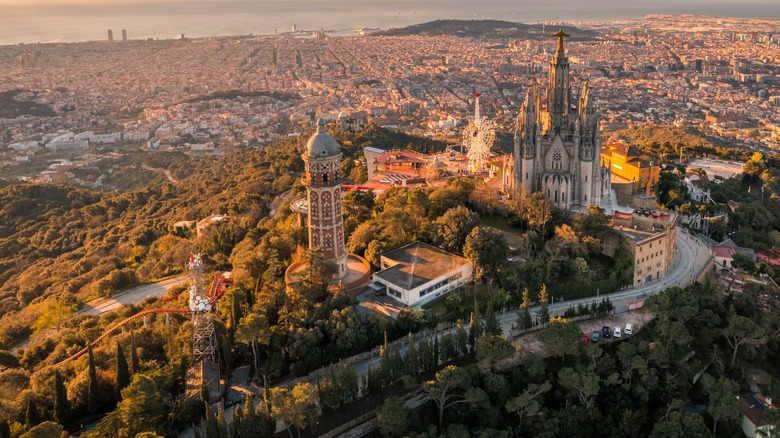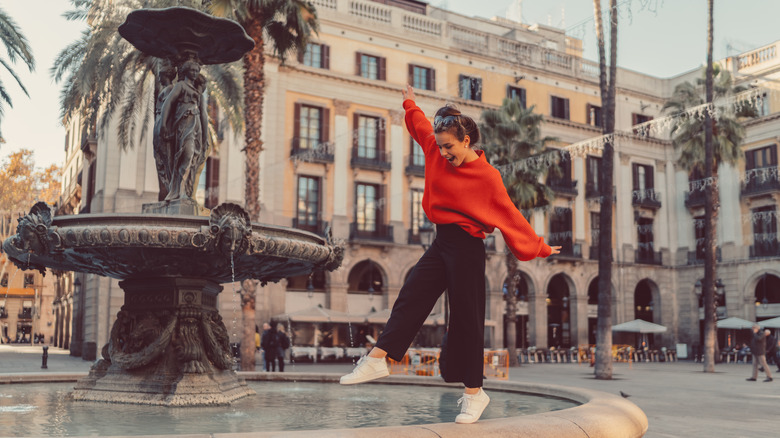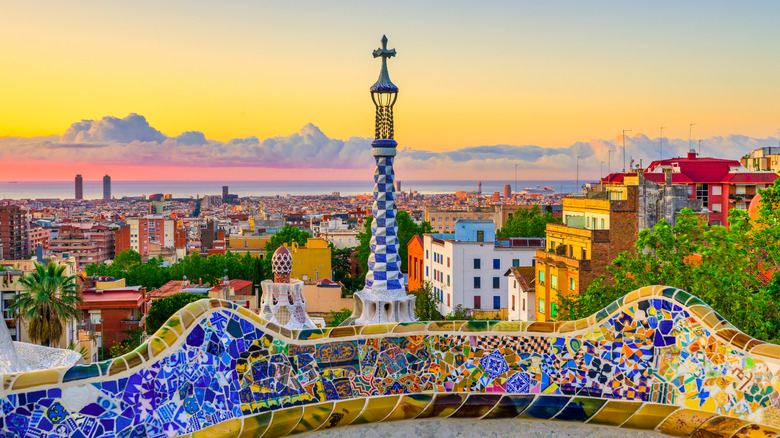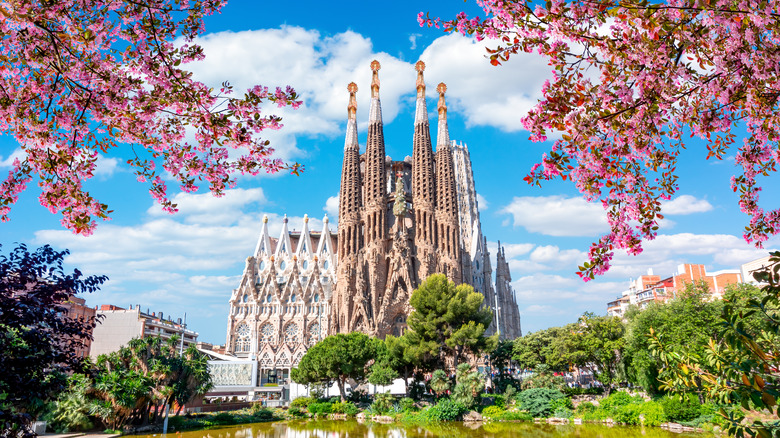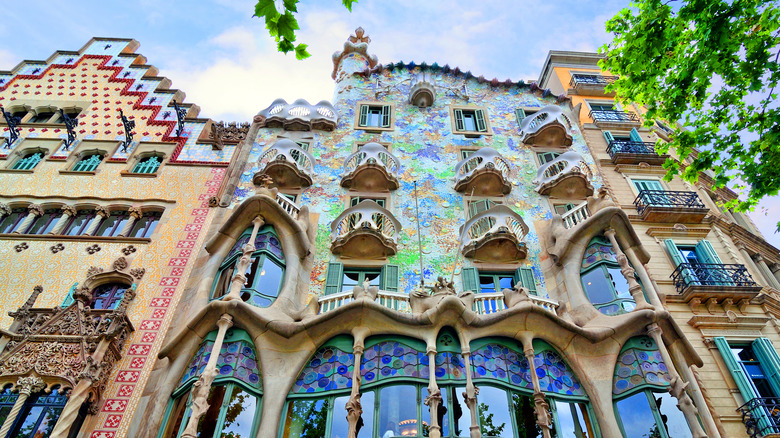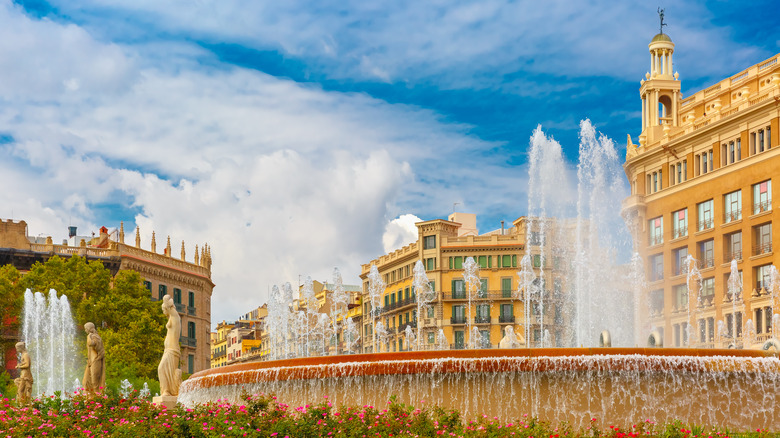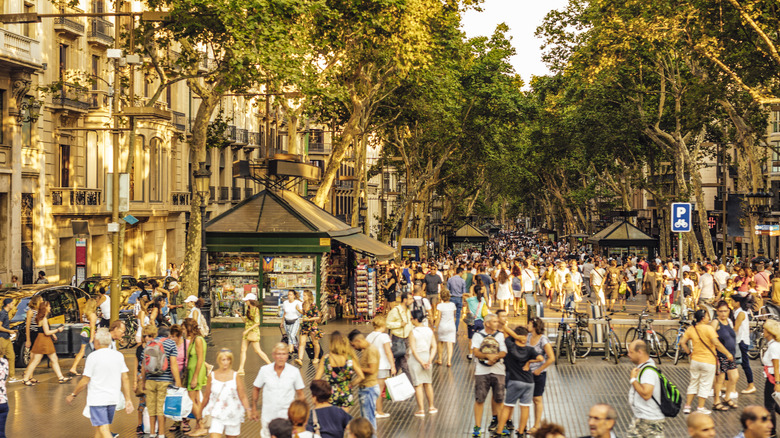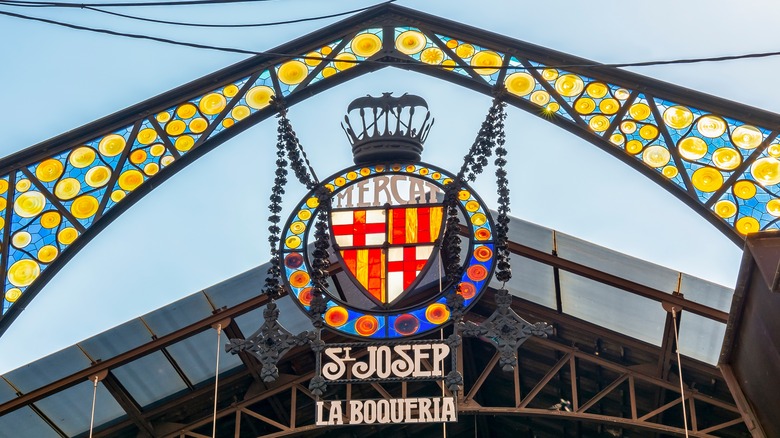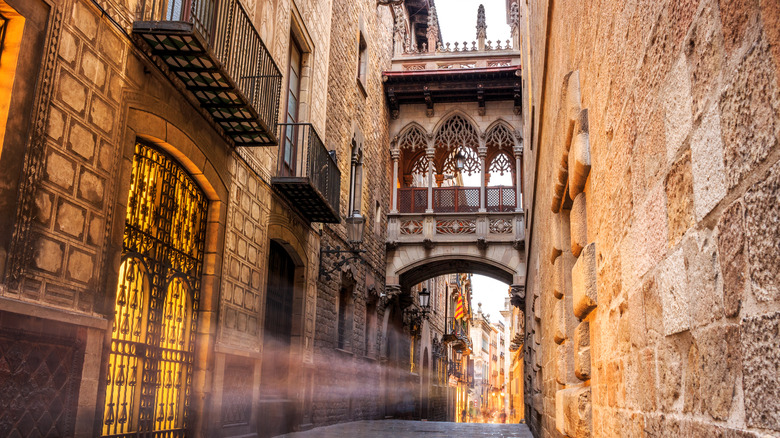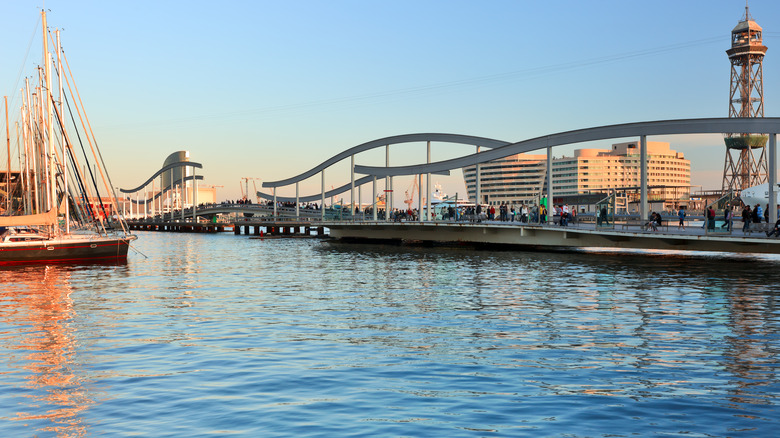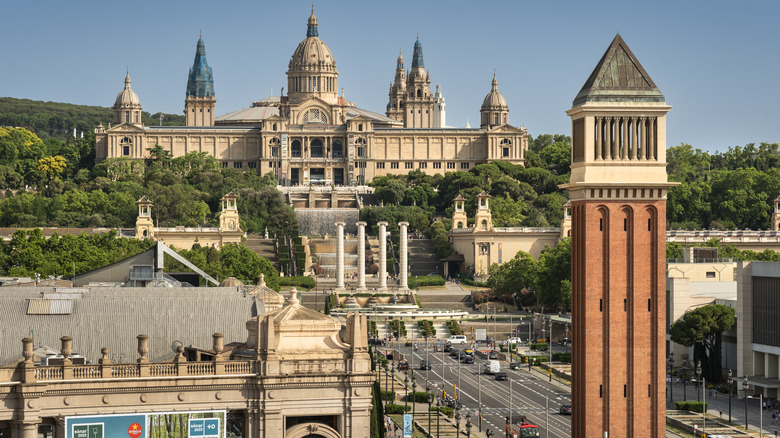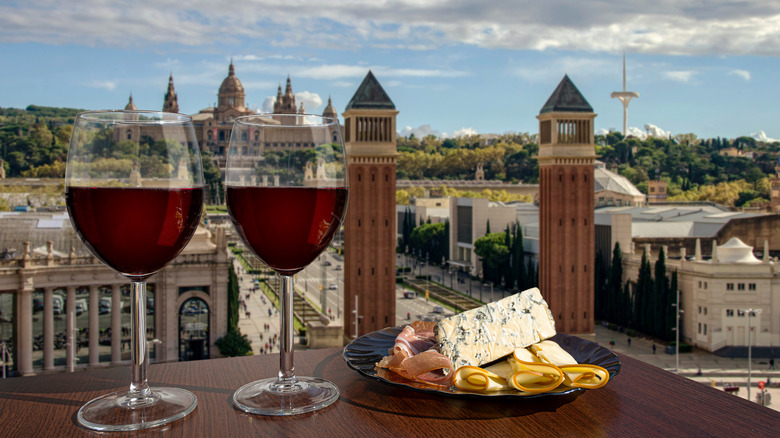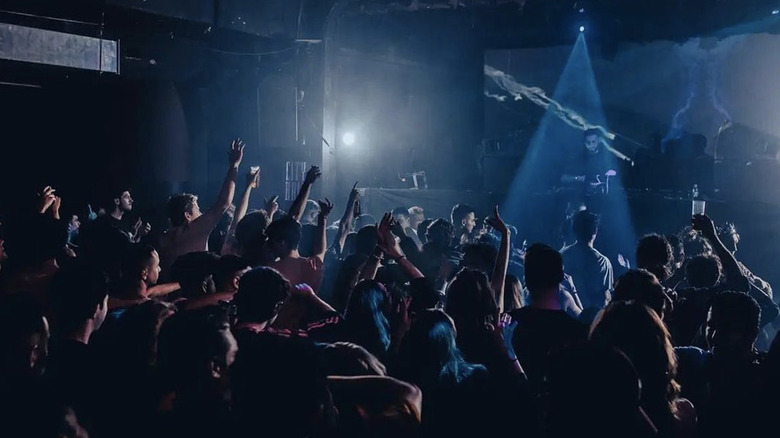The Best Things To Do In Barcelona If You Only Have One Day, According To Traveler Reviews
Do you want to do Barcelona in a single day? Estàs boig? That's Catalan for "Are you crazy?" because that's probably how a local would respond if you told them that plan. But for some reason, whether you're trying to jampack all the great European cities into a short vacation or just on a long layover, you only have 24 hours to see everything, from the beloved to the underrated attractions of one of the world's most intriguing, playful, exciting cities.
We dug through traveler reviews and guidebooks to find the city's best attractions and ordered them geographically. We start in Antonin Gaudí's fantastical Park Güell, make our way through a few of his other masterpieces, explore La Rambla and the Gothic Quarter, and then ascend Montjuïc before heading back down for a night of debauchery. You may not get to everything in just 24 hours, but even a fraction of these will make for one of the best days of your life.
General tips
Before you zoom around the city like a contestant on "The Amazing Race," there are some important tips to keep in mind. With so much to do in such a limited amount of time, you need to consider if you want to see a lot of a little or a little of a lot. The following list guarantees the latter. If you'd like to zoom in on a particular attraction or theme, think about what interests you the most: Would you like to book a tour that will take you through all of Gaudí's best work? Or spend the day in just the Gothic Quarter or Montjuïc? Or just want to chill by the Mediterranean all day with a glass of sangria?
If you want to do everything, here are some general guidelines. First, comfortable shoes, a backpack, and a bottle of water. Equally non-negotiable: Book tickets ahead of time. Lines for places like Sagrada Familia or Park Güell can last hours. It's also worth considering buying one of several pass options. These include the Barcelona Card, which includes free entry to many of the city's best museums; a Barcelona Pass, which includes skip-the-line tickets to Sagrada Familia and Park Güell; and the Go City All-Inclusive Pass, which includes free guided tours of Sagrada Familia, Park Güell, the Picasso Museum, and more.
Park Güell
Barcelona is a whimsical city, so it makes perfect sense to start your day staring at an 8-foot-tall tiled salamander smiling at you from its fountain perch. The salamander lovingly guards the entrance to Park Güell, Barcelona's inimitable, surrealist mountaintop city of gleaming tiled eccentricity.
The park is the masterwork of Antoni Gaudí, a Catalan architect and sculptor from the turn of the century who lent his signature modernist style to Barcelona's most famous buildings. In 1888, local businessman and count Eusebi Güell commissioned Gaudí to create a private city for the wealthy atop an unused hilltop. The land was never sold, and only two houses out of a planned 60 were built. One of them is the Gaudí House Museum, where the architect once lived. Güell eventually decided to turn it into a park; today, it is Barcelona's most popular attraction.
Start your day with brunch and coffee at the nearby Store Café, then head up the hill to Carrer d'Olot, the main entrance to the park. Make sure you book your tickets in advance through the park website. Then, marvel at the mosaic madness, which includes a gingerbread gatehouse, fountains, reservoirs, and Market Hall, a series of fluted columns holding up an expansive terrace on top of which visitors can walk. In addition to the monument section, amble around a free park full of trails, trees, and expansive city views.
La Sagrada Família
From Park Güell, it's about a 20-minute bike ride or 30-minute bus ride to Gaudí's other iconic masterpiece – La Sagrada Família, the modernist basilica that has become the enduring symbol of Barcelona despite being under construction for over 140 years.
Gaudí took over the project in 1883 and immediately replaced all existing plans with his idiosyncratic style. His vision was a church with three façades highlighting the main phases of Jesus's life — nativity, passion, and glory. Each of those three façades consists of four smaller towers representing the 12 Apostles of Jesus.
When Gaudí died in 1926 and was buried in the church crypt, the basilica was not even a quarter complete. The years since have been tricky — in 1936, anarchists broke into the church and set fire to a large part of Gaudí's workshop, including many of the plans for its completion. As a result, generations of architects have struggled to accurately fulfill Gaudí's vision. But there may be light at the end of the 442-foot spire: In September 2023, the foundation overseeing the church's construction announced that the four towers of the Evangelists were finally complete, and it looks like the church may actually be completed by 2026, the centennial anniversary of Gaudí's death.
Finished or not, there are going to be crowds. Buy tickets in advance, and consider buying a Barcelona City Pass that includes an audioguide and free skip-the-line entry tickets.
Casa Batlló
Most Barcelona visitors seem to agree that you can never get enough Gaudí. There's more than enough to go around — Barcelona counts 16 buildings in which he was involved and seven of his most famous works, which are all designated UNESCO World Heritage sites. But if we had to choose just one more, we'd go with Casa Batlló.
You'll spot the shimmering tiles, bone-like columns, and bright colors of this storybook apartment building along Passeig de Gràcia immediately. In 1903, industrialist Josep Batlló y Casanovas bought an existing building in the Eixample district and told Gaudí he could do whatever he wanted with it. Gaudí ran wild, creating an undulating façade of blue, green, and purple tiles; a rooftop emulating a dragon, and an interior inspired by marine life. There's hardly a straight line or right angle to be found — instead, there are stained-glass windows shaped like waves, a ceiling swirling like a sea around a chandelier, and an attic inspired by the bones of a whale.
A standard €31 ticket will buy you a 75-minute tour of the home, the rooftop, the attic, the redesigned basement featuring a rippling multi-floor aluminum chain curtain, and the Gaudí Cube, a 360-degree immersive deep dive into the "mind of Gaudí." A Gold ticket includes a visit to the private, furnished residence of the Batlló family and further immersive experiences into the mind and life of Gaudí.
Plaça de Catalunya
In Barcelona, all roads lead to Plaça de Catalunya, the 12-acre plaza often described as the city's "beating heart." Not only is it the nexus of several important roads, including Las Ramblas and Passeig de Gràcia, but it's long been a central site for rallies, festivals, parades, and protests — Barcelona's equivalent to Times or Trafalgar Square.
That may not be everyone's cup of tea, but as always, Barcelona keeps it cool. The busy square is full of fountains that light up at night, and many sculptures are situated around the plaza that represent various figures and ideas. The plaza is also surrounded by a series of handsome hotels and department stores, notably El Corte Inglés, a multilevel superstore providing superb city views and, crucial to the weary traveler, a public restroom.
The plaza is often cited as a good starting point for the day. Many tours start here, and it is the location of a large tourist information center where you can pick up a Barcelona Card and other passes. You can also catch an express Aerobus that provides direct service to the airport. At the midpoint of your day, it'll be a nice place to stop, regroup, sit on a bench, and take in the masses of people, pigeons, and performers swirling around the city center.
La Rambla
At the southern end of Plaça de Catalunya, you'll see loads of people walking toward all the trees. Follow them.
They're strolling down La Rambla, one of the most famous boulevards in Barcelona and the world. In fact, La Rambla is so famous it's inspired a verb — "ramblejar," which is used to describe walking down the middle of the tree-lined pedestrian walkway, where cars are relegated to the far ends of the street. Speaking of verbiage, the street is also known as Las Ramblas because even though it's less than a mile long, it is divided into five different "Ramblas."
"Rambla" comes from an Arabic word for "sandy riverbed," and this area is so-named because the street used to be a stream flowing outside the walls of the Gothic Quarter. In the 19th century, it began to transform into what it is today — a Parisian-style boulevard with outdoor restaurants, elegant shops, and every variety of street performers.
La Rambla is just under a mile long, stretching from the city center to the sea, but it packs a lot in. There's the Gran Teatre del Liceu opera house, the Miró Mosaic, and the stately Palau Güell designed by — you guessed it — Antoni Gaudí. Despite, or perhaps because of, its many attractions, the street has developed a reputation as an overpriced, noisy tourist trap. Beware pickpockets, and be aware that the street's southern end turns into a seedy red-light district at night.
La Boqueria Market
La Rambla's restaurants have a mixed reputation for being overpriced and often mediocre but tuck away into an alley next to a Dunkin' Donuts, and you'll find a labyrinthine maze of some of the best food in Spain.
Mercat de Sant Josep de la Boqueria, or La Boqueria, is one of the oldest and largest markets in the city. It started in 1217; more than 800 years later, it boasts more than 300 stalls of the freshest meats, cheeses, produce, wines, and tapas found anywhere. A map is essential, or consider booking a tasting tour with a local. Stalls on the right near the entrance generally sell to-go food like tacos, wraps, and empanadas. The market also offers a few sit-down restaurants and bars, like Bar Clemen's, which serves seafood and tapas; Kiosko Universal, famous for grilled seafood and vegetables; El Quim, renowned for its creative fried egg recipes; and Paella Bar Boqueria, whose name says it all.
Visitors like to wend their way through the crowds and snack on whatever strikes their fancy. Try Catalan specialties like fuet (dried thin sausage), salty pernil (ham), or olives and olive oil at Graus, to name just a few. Head toward the back of the market for more reasonable prices and smaller crowds. Gourmands should consider visiting some of the 39 markets spread around the city or embarking on one of the many Barcelona food tours, but La Boqueria is the place to start.
Gothic Quarter
If you thought 800-year-old La Boqueria was old, head across La Rambla and enter the Gothic Quarter, the site of the ancient Roman walled city from which Barcelona grew. Echoes of the city's rich, 2,000-year-old history pulsate from every corner of this photogenic maze.
Many visitors are content to simply stroll through the tangle of evocative alleyways, popping into the numerous artisanal shops, bars, and restaurants that are among the best in the city. We'd recommend a two-hour walking tour to cover the history behind the sites that make this one of Barcelona's most beloved neighborhoods. You'll walk through the neighborhood's many picturesque squares, including the Plaça Reial, the Plaça Sant Jaume, and Plaça Sant Felip Neri.
You'll undoubtedly stop to admire the jaw-dropping Catedral de Barcelona, a fourth-century cathedral as famous for its architecture as it is for the 13 geese who live in its cloister. You'll then wander through the narrow lanes of El Call, the medieval Jewish quarter of the city, and perhaps venture into the Temple of Augustus, an ancient Roman temple. You'll then walk the same streets where a young Pablo Picasso once lived and studied. If you have the time, the Picasso Museum, situated in five medieval palaces, is a stunning tribute to the art once produced just a few blocks away. Whatever you do, don't miss the Portal del Bisbe, the stunning Neo-Gothic bridge across the Carrer del Bisbe that's become an unofficial symbol of the neighborhood.
Columbus Statue and Rambla del Mar
After spending all day walking around a bustling city, you may have only seen a tantalizing glimpse of shimmering blue off in the distance. Barcelona guidebooks often focus on the city's art, architecture, and epicurean delights, leaving out its scenic, sizzling Mediterranean coastline. By trying to jampack all its main sights into one day, you may not have time for its great beaches either, but we thought we'd add in some invigorating salty sea breezes before you venture up Montjuïc.
At the end of La Rambla is the nearly 200-foot-tall Mirador de Colom, a statue of Christopher Columbus built for the 1888 Universal Exhibition. Columbus sailed into the nearby port in 1493, where he was received by King Ferdinand II upon his return from the so-called "New World." Take a quick jaunt up the first elevator built in Barcelona to enjoy panoramic views of the city, the sea, and the Montjuïc mountain.
When you get back down, head down Rambla del Mar, an elegant wooden walkway built in 1994 that connected La Rambla to the Port Vell, or old port. Take in gorgeous views of the harbor and mountains as you head to Maremàgnum, a high-end shopping mall that includes an IMAX theater, restaurants, and a large aquarium. If you're craving more beaches, take the V15 bus to the Sant Sebastià beach, which blends into the Sant Miquel and Barceloneta beaches.
Montjuïc
Like the Gothic Quarter, you'd need at least a day to explore all the treasures atop Montjuïc, the 583-foot hill that rises from the sea and looms over the city. The mountain is a city unto itself, boasting a castle, an Olympic stadium, numerous museums and gardens, and even a model village. At this point in the day, many attractions may be closed, and you may just want to stroll through a garden of roses, watching the sunset over the city.
But since we can almost guarantee you'll return to Barcelona now that your appetite is whetted, here are some of the mountain's top attractions to keep in mind. First, there's the 2,467-foot cable car that will bring you to the top of the mountain, granting panoramic city views. The cable car stops at the imposing Montjuïc Castle, a 17th-century fortress that has served as a castle, prison, and, currently, a military museum. After a castle tour, stroll through the acres of different botanical gardens, which offer an endless array of both native and exotic plants, trees, and flowers.
Amidst the greenery and views are several fascinating museums, including the Palau Nacional Art Museum and its waterfalls, the Joan Miro Foundation, the Catalan Museum of Archaeology, the Olympic stadium and two related sports and museums, and the Poble Espanyol, an open-air model town consisting of 117 full-scale buildings with architectural styles from all over Spain.
Dinner at Montjuïc
There's hardly a better way to cap off a long day in Barcelona than watching the sunset over the city while enjoying delicious food. Montjuïc boasts an astounding variety of restaurants, many of which offer commanding city views.
For top-notch views, try Òleum inside the Palau Nacional. From the enormous windows of the stately salon, you can see all of Barcelona while enjoying upscale Mediterranean cuisine. To ensure you don't miss a single inch of Barcelona from wherever you're sitting, try El Xalet de Montjuïc, a revolving outdoor restaurant serving upscale Spanish food like paella or lobster rice. La Caseta del Migdia on the grounds of Montjuïc Castle offers an outdoor terrace in the spring and summer that supposedly boasts the best sunset views in the city, often accompanied by live music. For great seafood on a terrace overlooking the port, try Martínez.
Many restaurants are located inside the Poble Espanyol village, and a reservation will also include a free ticket to the museum. At Tablao de Carmen, you can enjoy a tapas dinner, drinks, and a flamenco show. Enjoy more tapas, paella, jamón, wine, and desserts at the venerable Font de Prades, or pizza at Casa Massana.
For a whole new world of food and drink, including international options outside the traditional Catalan and Spanish fare, venture down the mountain to El Poble-sec, a lively neighborhood at the base.
Tour the nightlife
When the sun goes down, Barcelona really lights up. The city is regularly voted among the top nightlife capitals of the world, and tired as you may be, no trip to the city is complete without exploring what puts the "bar" in Barcelona.
You won't have to travel far. Montjuïc is surrounded by the city's nightlife centers, including El Poble-sec, El Raval, and the Gothic Quarter. For around $25, you can book several bar crawls with local guides, which often cover skip-the-line entry to two bars, two welcome shots, and nightclub entry. But if you just want to see where the night takes you, head to El Raval's Carrer Joaquín Costa, one of the city's central nightlife hubs. The street boasts many exciting bars, like Bar Olimpic, Casa Almirall, or the 1950s-themed Betty Ford's — no clinic jokes until a few drinks in, please.
To party in the footsteps of Pablo Picasso and Ernest Hemingway, try Bar Marsella, the city's oldest bar. Hemingway fans might also enjoy Boadas, where the owner trained at Hemingway's Floridita Bar in Havana. Wine fans will delight in Bar Brutal, where the walls are stacked with over 300 varieties. Anyone craving margaritas and mojitos should try La Rosa del Raval. Grungeheads will enjoy Nevermind, which is named after the famous Nirvana album.
Watch the sun come up at any of the city's famous clubs, including City Hall, Moog, or Red58, setting in motion another spectacular day in Barcelona.
